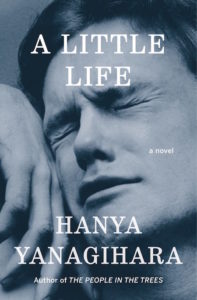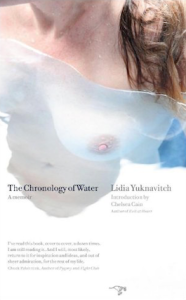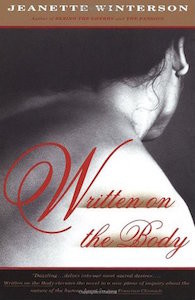Nine Unabashed Books
About Bodies
Pain, Pleasure, Bad Behavior... Cai Emmons Recommends
Her Favorites
Virginia Woolf says in her essay “On Being Ill”: “Literature does its best to maintain that its concern is with the mind; that the body is a sheet of plain glass through which the soul looks straight and clear, and, save for one or two passions such as desire and greed, is null and negligible and non-existent.”
Things have changed dramatically since Woolf was writing; many writers have made it their business to present the human body unabashedly, not as an adjunct, but as a central element in their work. When I think about the way bodies appear in my work, I see descriptions of hunger, fleeting pains, exhaustion, itching, sweating, etc., along with nagging concerns about body image. Having a body is an inescapable fact of the human condition, and it seems impossible to write authentically if we are not addressing such corporeal realities.
The books on this list are notable for the frank eye they bring to physical pleasure and pain, and the overall messiness of human bodies. They are united in their honest appraisal of the human body, their refusal to look away or speak in euphemisms, their understanding that the pleasures and indignities of human flesh are irrefutably present in all we do.
*

Mary Gaitskill, Bad Behavior
Mary Gaitskill’s short story collection, Bad Behavior, contains nine stories that feature lonely characters living in New York, working class and professional people, many of whom try to sedate themselves with drugs or sadomasochistic sex. Refusing the sensational, Gaitskill writes matter-of-factly, using plainspoken language to describe the sometimes shocking things her characters do to make their lonely lives more palatable. In the story “Romantic Weekend” she writes: “Queasily, he stripped off her clothes and put their bodies in a viable position. He fastened his teeth on her breast and bit her. She made a surprised noise and her body stiffened. He bit her again, harder. She screamed. He wanted to draw blood. Her screams were short and stifled. He could tell that she was trying to like being bitten, but that she did not. He gnawed her breast. She screamed sharply. They screwed. The broke apart and regarded each other warily.” Gaitskill’s objective, almost deadpan description of such scenes demands that the reader, too, does not turn away.

Leslie Jamison, The Empathy Exams
Leslie Jamison’s essay collection The Empathy Exams forays into various corners of human experience, but ultimately its central concern is the female body and pain. As a survivor of anorexia, cutting, alcoholism, as well as abortion, heart surgery, and numerous accidents, Jamison is uniquely equipped to address this subject. Part personal essay and part academic treatise, Jamison composes her pieces by synthesizing her own experiences alongside the work of other writers, thinkers, and artists. “I’ve got this double-edged shame and indignation about my bodily ills and ailments—jaw, punched nose, fast heart, broken foot, etc. etc. etc. On the one hand, I’m like, Why does this shit happen to me? And on the other hand, I’m like, Why the fuck am I talking about this so much,” she says of herself, in the final essay entitled “Grand Unified Theory of Female Pain.” Her final question in this essay is: “How do we represent female pain without producing a culture in which this pain has been fetishized to the point of fantasy or imperative?” Both self-disclosing and brainy, the book offers numerous riveting vignettes and deep dives into what it means to possess a body, in particular one of the female persuasion.

Hanya Yanagihara, A Little Life
Hanya Yanagihara’s novel A Little Life follows the friendship of four male college classmates as they move to New York to establish their lives and continue to know each other for decades. Each becomes accomplished in his field: one a painter, one an architect, one an actor, and Jude, the central character, becomes a brilliant litigator. It is Jude’s story that becomes the lynchpin for the book, as the legacy of early sexual abuse by a Brother has wreaked havoc on his psyche and his body. While Jude is universally admired and loved, the novel charts his slow deterioration, a body vanquished by too many scars, the physical scars a manifestation of the underlying scars on his soul. Yanagihara’s straightforward and detailed rendering of Luke’s anguish—abusive sex, cutting, illness—makes the book both a challenge to read and impossible to put down. It is one of the most immersive books I’ve read in the past decade.

Lidia Yuknavitch, The Chronology of Water
Like Jamison, Lidia Yuknavitch is interested in what it means to be born into a female body. But Yuknavitch’s response to that question in her memoir, The Chronology of Water, is less an academic treatise than a primal howl in which the body’s satisfactions and depredations are front and center. The book is loosely structured around the harrowing experience of giving birth to a dead daughter, but Yuknavitch ventures into many other elements that have shaped her life—an abusive father and alcoholic mother, her love of swimming, her three husbands, her abortions, her relationships with women—putting together a pastiche-like portrait of what living in a female body has meant to her. “Ask me about my life as a sexualized, gendered body and I can tell you tales. Endless stories of a woman who was me and is all of us. Our bodies the flesh metaphor for all human experiences.” Describing one memorable sexual threesome with two other women she writes: “Sometimes Claire on all fours me and Hannah filling every hole licking every mouth rubbing her clit making her scream making her entire corpus shiver her head rock back her woman wail let loose gone primal cum and shit stains and spit and tears.” Yuknavitch’s unrestrained language—honest, uncensored, unapologetic—delivers a good part of this book’s satisfaction.

Roxane Gay, Hunger: A Memoir of (My) Body
Hunger: A Memoir of (My) Body, Roxane Gay’s candid personal story of rape and sexual abuse as a 12-year-old girl that led to extreme weight gain in an attempt to bury the trauma, stands out on this list for being the only book that examines the prevailing cultural view about bodies, in particular fat bodies. “This is a memoir of (my) body because, more often than not, stories of bodies like mine are ignored or dismissed or derided.” The book begins with Gay’s personal journey through abuse as a child then details the years that followed in which she gained weight, ate secretly, and tried futilely to lose weight. Then she turns her eye to the social stigma attached to being fat, the way the culture, particularly as seen through the media, excoriates fatness and glorifies thinness. “To tell the story of my body is to tell you about shame—being ashamed of how I look, ashamed of my weakness, the shame of knowing it is in my power to change my body and yet, year after year, not changing it.” Gay’s narrative is unflinching, sometime snarky, always smart. Hunger is so honest it breaks your heart.

Ottessa Moshfegh, Eileen
Ottessa Moshfegh’s debut novel, Eileen, narrates the story of the eponymous character who lives a squalid life taking care of her alcoholic father and working a day job as secretary at a boys’ prison while dreaming of improbable escape. Bodies and bodily functions figure prominently throughout this creepy and humorous novel. A self-described prude, Eileen says: “I worried that when anyone’s eyes cast downward, they were investigating my nether regions and could somehow decipher the complex and nonsensical folds and caverns wrapped up so tightly down there between my legs.” But Eileen’s prudishness is a sly contrast to the writer’s sensibility, which is far from prudish.
Moshfegh describes Eileen’s bowel movement rituals almost gleefully. “The closest bathroom was one floor down and I shared it with my father. Moving my bowels there never felt quite right. I worried that the smell would carry downstairs to the kitchen, or that my father would come knocking while I sat there on the toilet. Furthermore, I’d become dependent on those laxatives. Without them my movements were always pained and hard and took a good hour of clamping down and kneading my belly and pushing and praying. I often bled from the effort, digging my nails into my thighs, punching my stomach in frustration.” Such frank descriptions of body functions are among the most startling body passages I’ve read in fiction.

Ocean Vuong, On Earth We’re Briefly Gorgeous
Ocean Vuong’s elegiac autobiographical novel On Earth We’re Briefly Gorgeous portrays bodies in a both tender and harrowing way. The book is framed as a letter to his deceased mother, a Vietnamese immigrant who worked in a Connecticut nail salon and suffered from war-induced PTSD, making her alternately violent with her son then filled with remorse. The narrator excavates his own memory and imagination to reconstruct his mother’s life, looking to honor her and find meaning in her trauma as well as his own. Some of the most touching moments are when physical gestures between mother, son, and grandmother convey the love they can rarely express with words.
The narrator plucks his grandmother’s white hairs. He scrapes his mother’s skin with a coin, on her instruction, and “through this careful bruising, you heal.” Studying his mother’s hands, marked by years of manual labor, he is acutely aware of the power of the body to speak. “I hate and love your battered hands for what they can never be.” Later, when he meets Trevor, the redneck boy who becomes his lover, their communication is also more physical than verbal. Their sex is transporting, but it can only fleetingly erase the wounds they both hold. “His cock in my hand, we began. My grip tightened around the covers. And that inertia of his skin, damp-tight against my own, made the task feel, not merely of fucking, but of hanging on.”

Garth Greenwell, What Belongs to You
Garth Greenwell’s debut novel, What Belongs to You, narrates the relationship between an American teacher in Bulgaria and the man he meets in a public bathroom. The narrator is compulsively drawn to this man, Mitko, despite feeling (knowing) that Mitko is taking advantage of him. The on-again, off-again relationship careers back and forth from tenderness and possible love to predatory transactional sex and exploitation. But it is not the sex that is the most striking aspect of this novel, rather it is the writer’s attention to the language uttered by the body—the nuances of physical gestures and facial expressions and the array of emotions they bespeak. The narrator is highly observant, attenuating the action as he tries to interpret body messages, his own as well as Mitko’s.
Near the end of the book as Mitko’s unstable life and addictions have gotten the better of him, the narrator comes to a reckoning over Mitko’s failing body: “I felt his body all along my own, his body that had been, in however partial or compromised or intermittent my fashion, beloved to me. As I pressed my face to his neck and breathed him in, his scent sour with sweat and alcohol, it seemed impossible it could dissolve, simply dissolve, this form I had known so intimately with my hands and my mouth, it was unbearable that this body so dear to me should die. But though I held him more tightly the space that had opened up between us remained and I knew I would stay on the other side of it, the side of health…”

Jeanette Winterson, Written on the Body
In Jeanette Winterson’s novel Written on the Body the human body is seen as the repository of love. The novel narrates the passionate but doomed love affair between the female narrator and a married woman named Louise. At the outset, the narrator travels over every inch of Louise’s body as if to memorize it. “What other places are there in the world than those discovered in a lover’s body?…I was holding Louise’s hand, conscious of it, but sensing too that a further intimacy might begin, the recognition of another person that is deeper than consciousness, lodged in the body more than held in the mind.” The narrator tries to remove herself from the relationship but remains madly in love and, when Louise is diagnosed with cancer, the narrator becomes even more obsessed with anatomy.
“If I could not put Louise out of my mind I would drown myself in her. Within the clinical language, through the dispassionate view of the sucking, sweating, greedy, defecating self, I found a love-poem to Louise. I would go on knowing her, more intimately than the skin, hair and voice that I craved. I would have her plasma, her spleen, her synovial fluid. I would recognize her when her body had long since fallen away.” Subsequent sections of the book are titled: “The Cells, Tissues, Systems and Cavities of the Body,” “The Skin,” “The Skeleton,” and “The Special Senses.” Lyrical and romantic, Winterson makes a strong case for love being inextricable from bone, organs, blood, and all the body’s messy functions.
__________________________________

Cai Emmon’s novel Vanishing is now available from Leapfrog Press.




















